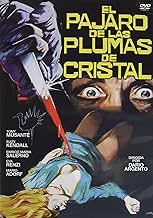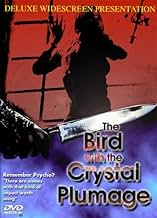VALUTAZIONE IMDb
7,1/10
25.326
LA TUA VALUTAZIONE
Uno scrittore che è testimone di un'aggressione viene perseguitato da un serial killer.Uno scrittore che è testimone di un'aggressione viene perseguitato da un serial killer.Uno scrittore che è testimone di un'aggressione viene perseguitato da un serial killer.
- Premi
- 2 vittorie e 1 candidatura in totale
Renato Romano
- Professor Carlo Dover
- (as Raf Valenti)
Rosita Torosh
- 4th Victim
- (as Rosa Toros)
Dario Argento
- Murderer's Hands
- (non citato nei titoli originali)
Trama
Lo sapevi?
- QuizIt has been alleged that Tony Musante --- known for his intensity and preparedness as an actor --- would frequently show up at Dario Argento's apartment at 3 am to discuss characterization, much to Argento's annoyance.
- BlooperWhen pursuing the hit man "Needles", Sam describes him to a hotel bellboy as wearing a yellow jacket and a blue cap. At no point is Needles seen wearing a blue cap, although he does manage to shake off his pursuer by mingling with a group of people wearing such a uniform. However, Sam only sees them after giving the description.
- Citazioni
Inspector Morosini: Right! Bring in the perverts!
- Versioni alternativeWest German theatrical version was cut by ca. 10 minutes (plot scenes). For TV broadcasting these scenes were reinserted but the violent scenes were trimmed instead.
- ConnessioniEdited into Tales of the Cat (2001)
Recensione in evidenza
The Bird with the Crystal Plumage was Dario Argento's first film and it made him a hot property. Having had very little experience with actual filmmaking, he showed incredible potential with his debut and he took full advantage of it in years to come. Here he explored a lot of the scenarios that would later charectarize his films.
With this film, and particularly his next, Dario showed he had been influenced quite a bit by the great Alfred Hitchcock. The theme here; an american in a foreign country becomes a witness to a heinous crime and starts investigating himself; bears more than a little resemblance to many of Hitchcock's films. An innocent man finds his morbid curiosity getting the better of him and as he progresses in his investigations he puts himself in grave danger. The story unfolds in a similar way to Hitchcock's films, clues are gathered periodically and there's a surprise in the end which is hard to guess, but not impossible.
Argento gradually builds up the suspense and creates a genuinely intriguing mystery. The film never slows down too much and it never fails to be interesting. It's also got a surprising amount of laughs. But in comparing Argento to Hitchcock, Argento manages to create a style of his own, which he would perfect in Profondo Rosso aka Deep Red a few years later. That's of course the visual style. Here he has the assistance of one Vittorio Storaro and the visual aspect of this film is one of it's greatest assets. The film is wonderfully lit every single time and Argento switches effortlessly between dark and dreary visuals to shiny happy images. Argento's visual style is one of his greatest trademarks and it bears some influence from the likes of Mario Bava. I don't want to name any particular scenes, they all flow well together.
Another terrific Argento trademark is the music. Ennio Morricone's score is nothing short of fantastic, ranges from cathcy repetetive melodies to haunting sounds of fear. I think the impact from Argento's films would lessen considerably would it not be for those terrific scores he gets every time.
However, Argento is not perfect. He seems to lessen his standards when it comes to the acting department. Here, the characters are a bit wooden and he doesn't give them all that good lines to deliver. The dialogue in many of his films seem a little childish. And it doesn't look like he gives them many instructions, the acting here (and in most of his films) is shaky and not very consistent. It has been said about Argento that he basically thinks of actors as human props, what's most important is where they are positioned and how they move. Also, it's very annoying how he dubs every film, even the american actors have to do voice overs on themselves.
That said, Argento has more pro's than con's. His films are always interesting and wonderful to look at. The Bird with the Crystal Plumage is in my opinion one of his best. 9 out of 10.
With this film, and particularly his next, Dario showed he had been influenced quite a bit by the great Alfred Hitchcock. The theme here; an american in a foreign country becomes a witness to a heinous crime and starts investigating himself; bears more than a little resemblance to many of Hitchcock's films. An innocent man finds his morbid curiosity getting the better of him and as he progresses in his investigations he puts himself in grave danger. The story unfolds in a similar way to Hitchcock's films, clues are gathered periodically and there's a surprise in the end which is hard to guess, but not impossible.
Argento gradually builds up the suspense and creates a genuinely intriguing mystery. The film never slows down too much and it never fails to be interesting. It's also got a surprising amount of laughs. But in comparing Argento to Hitchcock, Argento manages to create a style of his own, which he would perfect in Profondo Rosso aka Deep Red a few years later. That's of course the visual style. Here he has the assistance of one Vittorio Storaro and the visual aspect of this film is one of it's greatest assets. The film is wonderfully lit every single time and Argento switches effortlessly between dark and dreary visuals to shiny happy images. Argento's visual style is one of his greatest trademarks and it bears some influence from the likes of Mario Bava. I don't want to name any particular scenes, they all flow well together.
Another terrific Argento trademark is the music. Ennio Morricone's score is nothing short of fantastic, ranges from cathcy repetetive melodies to haunting sounds of fear. I think the impact from Argento's films would lessen considerably would it not be for those terrific scores he gets every time.
However, Argento is not perfect. He seems to lessen his standards when it comes to the acting department. Here, the characters are a bit wooden and he doesn't give them all that good lines to deliver. The dialogue in many of his films seem a little childish. And it doesn't look like he gives them many instructions, the acting here (and in most of his films) is shaky and not very consistent. It has been said about Argento that he basically thinks of actors as human props, what's most important is where they are positioned and how they move. Also, it's very annoying how he dubs every film, even the american actors have to do voice overs on themselves.
That said, Argento has more pro's than con's. His films are always interesting and wonderful to look at. The Bird with the Crystal Plumage is in my opinion one of his best. 9 out of 10.
I più visti
Accedi per valutare e creare un elenco di titoli salvati per ottenere consigli personalizzati
- How long is The Bird with the Crystal Plumage?Powered by Alexa
Dettagli
- Data di uscita
- Paesi di origine
- Lingua
- Celebre anche come
- The Bird with the Crystal Plumage
- Luoghi delle riprese
- Aziende produttrici
- Vedi altri crediti dell’azienda su IMDbPro
Botteghino
- Budget
- 500.000 USD (previsto)
Contribuisci a questa pagina
Suggerisci una modifica o aggiungi i contenuti mancanti

Divario superiore
By what name was L'uccello dalle piume di cristallo (1970) officially released in India in English?
Rispondi
























